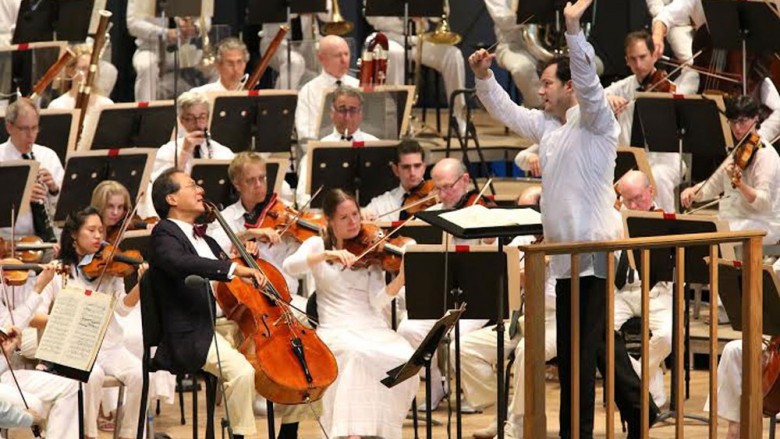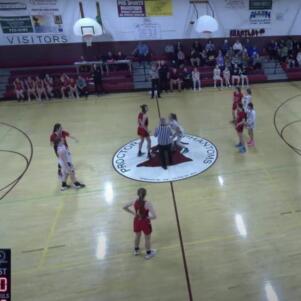Yo-Yo Ma’s lyrical prowess on display at BSO concert
By Mary McCleary | August 5, 2015, 11:57 EDT

On Sunday August 2, Andris Nelsons conducted the BSO in a delightful Tanglewood concert featuring cellist Yo-Yo Ma. The other soloists were trumpet player Håkan Hardenberger and BSO principal violist Steven Ansell. The selection of music was an imaginative blend of classical elegance with two contrasting programmatic works. Joseph Haydn’s Symphony No. 90 in C preceded Brett Dean’s Dramatis personae, Music for Trumpet and Orchestra. The storytelling element of Dean’s starkly modern work proved a fascinating study juxtaposed against Richard Strauss’s tone poem, Don Quixote: Fantastic Variations on a theme of knightly character.
The opening piece, Haydn’s Symphony No. 90 (1788), is not among the composer’s well-known works, but it is nevertheless a charming composition. In the first Adagio-Allegro assai movement, Andris Nelsons conducted with a tranquil, even playful interpretation, though not a passionate one. He was particularly adroit at inspiring nuanced pianissimo playing from the orchestra, and was also very adept at using musical pauses to capture the audience’s attention. When a composer calls for brief rests in the music, the momentary silence can be even more arresting than a fierce sforzando.
In the Andante and the Menuet/Trio movements, Nelsons was able to elicit emotional gradation from the musicians, particularly in the unaccompanied violin sections, which were performed splendidly. In the Finale, the audience was startled by Haydn’s little joke of fooling them with his “false” ending: as the music reaches its climax and the applause begins, the strings resume playing in an entirely new key. It was a light-hearted – if disconcerting – end to a very pleasant piece and performance.
Brett Dean’s Dramatis personae was an intense, bracing divergence from Haydn. The Australian composer wrote the work in 2013 for Håkan Hardenberger, whom many consider as the finest trumpeter on the concert circuit. Hardenberger did not disappoint, regaling the audience with his virtuoso playing and artistic jauntiness. Nelsons also seemed to draw on his own early experience as a trumpet player in the Latvian National Opera Orchestra, and was distinctly in his element conducting the piece.
In order to appreciate Dean’s work, it is crucial that the audience understand the context of its plot beforehand. In the first movement “Fall of a Superhero,” the trumpet soloist assumes the role of superhero protagonist in the comic thriller genre. The lead confronts his adversaries, who are played by different musicians in the orchestra. As the trumpeter stands in the middle, the various instrument sections attack from all sides. They then join forces to collectively overcome the hero, eventually drowning him out in a cacophony of sound.
The composer certainly accomplished the task of creating the suspenseful atmosphere of an action movie, and his use of multiple percussion and cinematic sound effects was very credible. Hardenberger was a colorful, convincing presence as he brandished his trumpet like weapon; it definitely felt as if one were being led on a chase scene with him.
In the second movement “Soliloquy,” the trumpet soloist muses aloud, so to speak, about his predicament. The musical atmosphere is reminiscent of 1960s sci-fi scenes. One could almost imagine Captain Kirk finding himself alone on an alien planet wondering aloud what he should do. Hardenberger effectively used the trumpet like an actor’s inner voice, giving a hypnotic, even psychedelic tone to the piece.
The concert closed with Strauss’s Don Quixote (1897). It is a witty, elusive, and poignant piece that was masterfully brought to life by Yo-Yo Ma. The cellist assumed Cervantes’s role with perceptive acumen, and violist Steven Ansell interpreted Sancho Panza astutely. Strauss called for a very large orchestra, including percussion instruments such as small bells, tambourine, triangle, and even a large wind machine. Together with the expanded woodwind and brass sections, they helped narrate the story.
After the Introduction, the tone poem followed a theme and variation format as Don Quixote embarked on his famous adventures. Similar to Dean’s frenzied suspense scenes, Strauss used dissonance to convey his protagonist’s distressed state of mind. However, Strauss proved the better creator of a cinematographic impression by balancing atonal fracas with harmonious resolution.
The duets between Ma and Ansell were superbly executed. Ansell educed rich, deep hues from his viola whilst Ma brilliantly described the emotive, dreamlike scenes. It was difficult at times to distinguish between the variations and thus follow the storyline, but that was more the fault of the score than the conducting, which was excellent.
In the stirring Finale, the orchestra mirrors Don Quixote’s return to sanity on his death bed. Nelson’s experience as an operatic conductor was fully on display, as he balanced the deeply personal, aria-like quality of the solo playing with the broad orchestral narration. Yo-Yo Ma played impeccably well, turning his cello into an actor for the diverse Quixote role, which ranged from the humorous to the somber. Perhaps he can give his cello a new surname – Callas – since, like the great dramatic soprano, he is able to sustain sweeping lyrical lines with consummate delicacy and refinement.
Contact Mary McCleary at [email protected]










